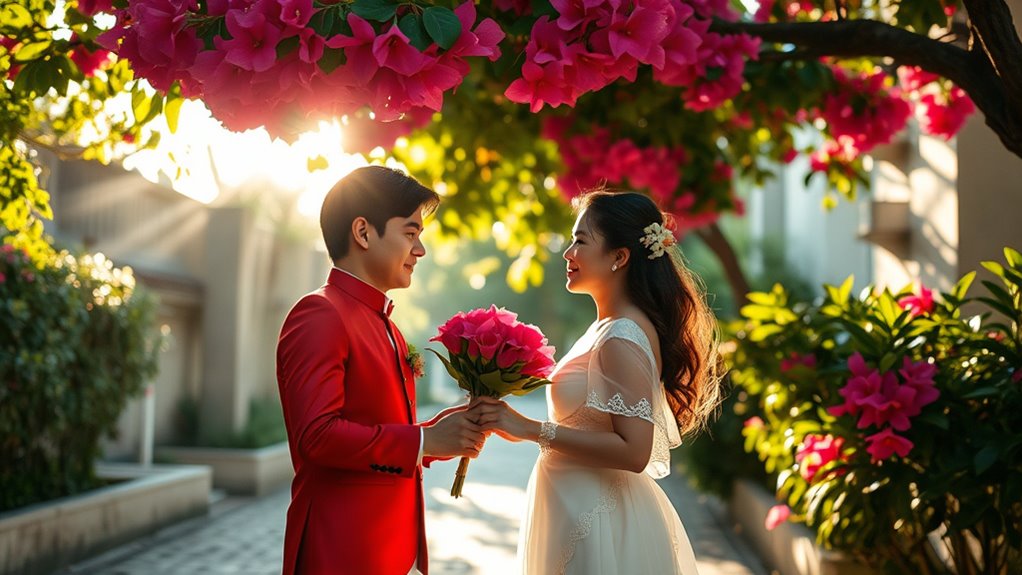Courting a Filipina the traditional way means respecting family and engaging in heartfelt gestures. You’ll need to seek parental permission and participate in practices like harana, a serenade that showcases your sincerity. Handwritten letters are essential for expressing your feelings, while paninilbihan, or performing service for her family, demonstrates your dedication. Don’t forget the pamamanhikan, where you formally seek their blessings. Want to explore more about these beautiful traditions? There’s so much to discover!
Key Takeaways
- Engage with the entire family early on to show respect and gain their approval during the courtship process.
- Participate in the harana tradition to express sincerity and showcase your musical talents to the intended partner.
- Demonstrate responsibility through *paninilbihan*, performing tasks for the woman and her family to build trust and commitment.
- Use handwritten letters to articulate your feelings, reflecting sincerity and the cultural significance of romantic expression.
- Seek formal introductions and approval through *pamamanhikan*, emphasizing the importance of family involvement in the engagement process.
Understanding the Importance of Family in Filipino Courtship
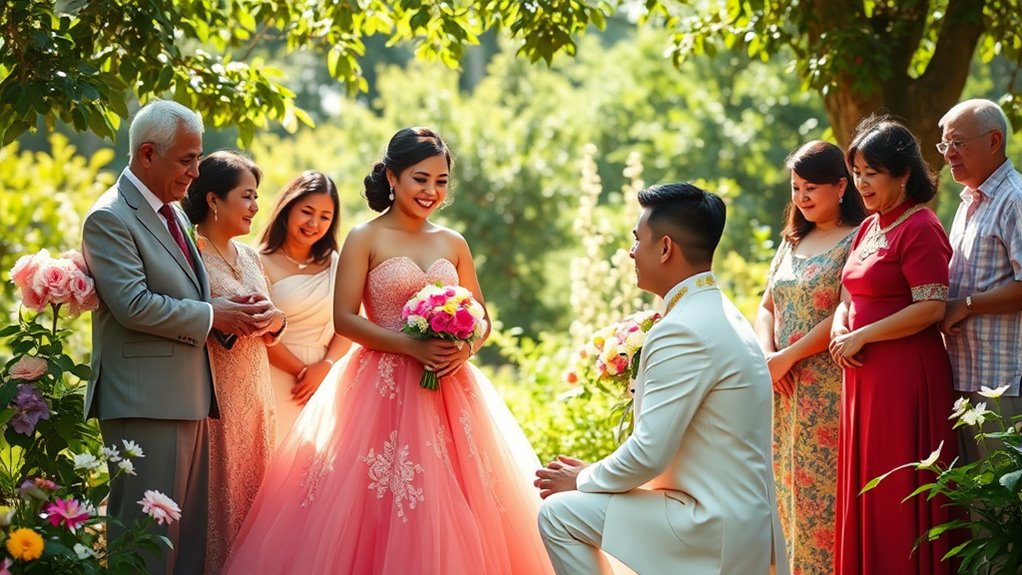
In Filipino courtship, understanding the importance of family is essential, as it forms the backbone of social interactions. Family isn’t just a unit; it’s a community that extends to relatives and friends, creating strong bonds.
When courting, you must engage with the entire family, not just the woman. Seeking her parents’ permission shows respect for their authority, and bringing *pasalubong* during visits helps establish goodwill. Additionally, the suitor is expected to court the entire family, reflecting the cultural significance of familial ties in relationships.
Initial meetings often happen in family settings, emphasizing their role in the process. Dressing appropriately and using proper titles demonstrates your seriousness and respect.
Embracing Cultural Practices: The Role of Harana

Harana, a beautiful tradition of serenading, plays a significant role in Filipino courtship. This practice, influenced by Spanish serenata, beautifully blends local dialects and themes, enriching your expression of love.
When you serenade your beloved at night, under her window, you’re not just showcasing your musical talents; you’re also demonstrating vulnerability and sincerity. It’s a communal affair, often involving friends, which highlights the importance of community participation in Filipino culture.
The silent exchanges during this act—like her lighting a candle—signify acceptance or rejection, making the moment even more special.
Though less common today, the spirit of harana endures, reminding you of the values of respect, patience, and heartfelt connection in relationships. Embrace this tradition to deepen your romantic pursuits.
The Significance of Handwritten Letters in Expressing Feelings

Beyond the enchanting moments of harana, another timeless way to express your feelings in Filipino courtship is through handwritten letters.
These letters allow you to articulate your emotions with poetic flair, often in Tagalog or other dialects, reflecting sincerity and depth. Inspired by the romantic letters of national heroes like Dr. Jose Rizal, this practice highlights patience and understanding in your courtship journey. In the same way that a budget plan helps manage financial resources, a well-crafted letter can manage the emotional resources of love.
Sending letters through intermediaries shows respect and caution, making each note a cherished gesture of commitment. Handwritten letters symbolize devotion and loyalty, demonstrating your willingness to wait and invest in the relationship.
Even in today’s digital age, a heartfelt letter remains a unique and intimate expression of love, transcending conventional communication methods. Additionally, the importance of communication in relationships emphasizes the value of meaningful exchanges, just as handwritten letters do.
Demonstrating Responsibility Through Paninilbihan

While you navigate the intricate dance of Filipino courtship, demonstrating responsibility through paninilbihan becomes vital. This traditional custom shows your sincerity and commitment by performing various tasks for the woman you’re courting and her family.
You might find yourself chopping firewood or fetching water—simple chores that speak volumes about your character. Engaging in paninilbihan builds trust with her family, as they observe your attitude and willingness to contribute.
Chopping firewood and fetching water reveal your character, fostering trust with her family through your willingness to contribute.
This respect for tradition highlights your dedication and seriousness about a long-term relationship. Remember, gaining her family’s approval is important, so embrace the opportunity to showcase your work ethic and responsibility.
Paninilbihan isn’t just a task; it’s a stepping stone towards a meaningful connection.
The Art of Serenading: A Musical Expression of Love

As you continue to express your sincerity in your courtship journey, embracing the art of serenading can elevate your efforts. Known as harana, this cherished tradition involves singing outside a woman’s window, often with friends strumming guitars.
It reflects the cultural significance of respect and vulnerability in Filipino courtship. Through the emotional melodies of kundiman, you create an intimate connection, allowing your heartfelt lyrics to express love and devotion.
Engaging the community can enhance your serenade, as local musicians, or master haranistas, may join in. Remember, this practice also honors her family, reinforcing the importance of respect.
Ultimately, harana symbolizes your serious intent and commitment, making it a beautiful expression of love.
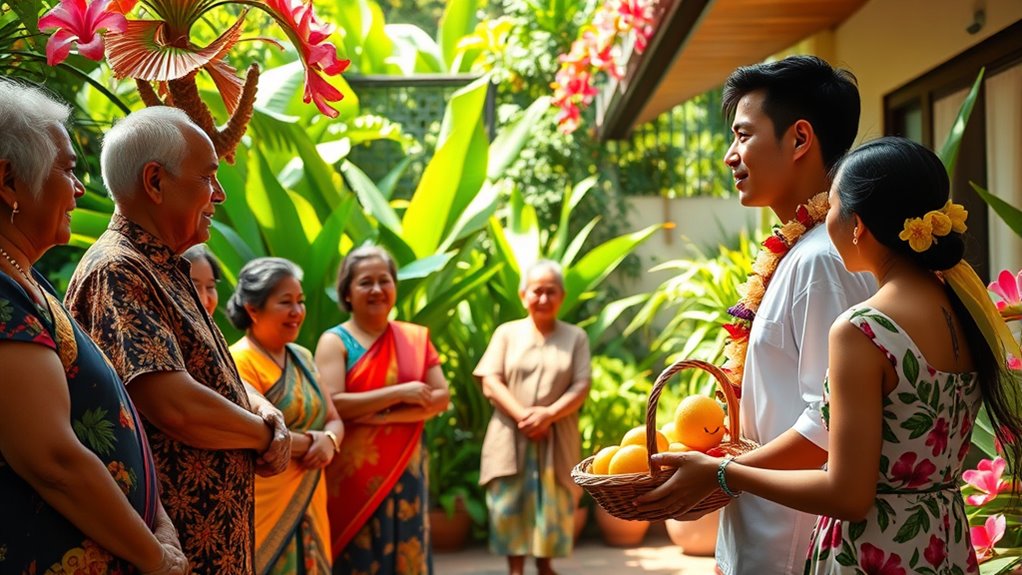
How can you navigate the intricate world of communication in traditional Filipino courtship? Intermediaries, like friends and family, play an important role in this process. They introduce you to potential partners, often through playful teasing known as *tuksuhan*, which helps gauge mutual interest.
Love letters are usually delivered by these intermediaries, showcasing your patience and affection. Gaining approval from elder family members is also essential, and intermediaries facilitate this significant step.
Respect and etiquette are key; meetings are scheduled under their supervision and typically take place in formal settings. This traditional approach emphasizes modesty and builds trust, ensuring that both families are involved and supportive, ultimately strengthening bonds between you and your partner’s family.
The Tradition of Pamamanhikan: Seeking Family Blessings
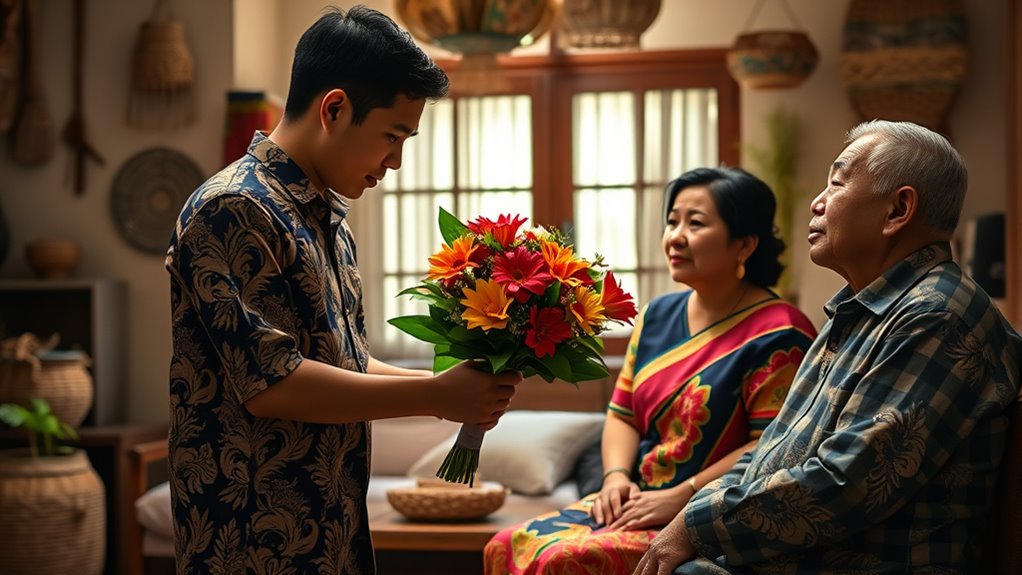
Steering through the world of traditional Filipino courtship naturally leads to the tradition of pamamanhikan, where seeking family blessings takes center stage.
This cherished practice traces its roots back to pre-colonial times, symbolizing respect for the bride’s family, especially the elders. During pamamanhikan, you formally ask for your beloved’s hand in marriage, fostering interfamily bonding and reinforcing cultural values.
Expect to bring gifts, or *pasalubong*, as tokens of goodwill. This event typically unfolds at the bride’s or groom’s home, allowing respectful dialogue about wedding plans and family expectations.
Bringing gifts, or *pasalubong*, fosters goodwill during pamamanhikan, creating a space for respectful discussions on wedding plans.
Ultimately, pamamanhikan emphasizes unity and cooperation, ensuring both families are invested in the journey toward marriage.
The Impact of Modern Influences on Traditional Courtship

Modern influences have dramatically reshaped traditional Filipino courtship, blending time-honored customs with contemporary practices.
You’ll notice that many young Filipinos now adopt more direct and liberal approaches, thanks to Western cultural influences. Technology plays a huge role, as social media and texting allow for easier communication and relationship initiation, often bypassing family involvement.
Traditional methods, like serenading, are fading, while both genders increasingly take the lead in courting. Urban lifestyles contribute to a quicker, more open courtship process, reflecting changing social norms.
Although some traditional elements remain, such as respectful family introductions, you’ll find that modern courtship is marked by a mix of old and new, creating a unique landscape for romance in the Philippines today.
Balancing Tradition and Modernity in Filipino Dating
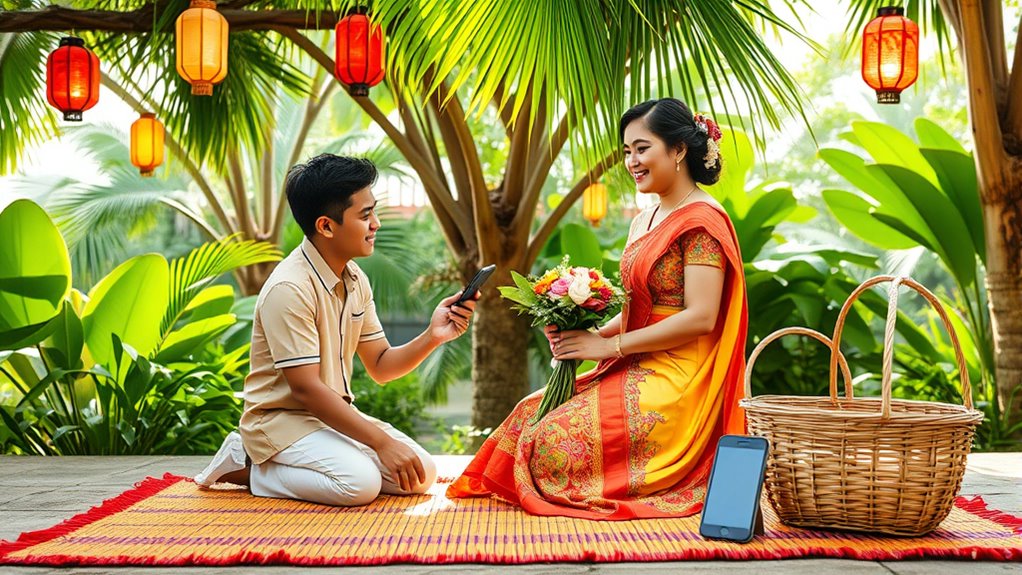
As Filipino dating evolves, blending traditional customs with modern influences becomes increasingly common.
You might find that while traditional courtship practices still hold strong, younger generations are integrating digital communication, like texting and social media, into their interactions. This combination allows for a more relaxed approach, while still respecting the vital elements of family approval and sincere intent.
For instance, you could express your feelings through a heartfelt handwritten letter, but also follow up with a quick text to keep the conversation flowing.
While the pace of courtship may quicken due to mutual attraction, the essence of respect and commitment remains paramount.
Balancing these elements creates a unique dating experience that honors both heritage and individuality.
The Path to Engagement: Cultural Expectations and Practices

While steering the path to engagement in Filipino culture, you’ll find that various cultural expectations and practices shape the journey.
Initially, during the “panliligaw” phase, you’ll formally introduce yourself and show respect by helping with household tasks. Seeking approval through “pamamanhikan,” where you visit her family, is essential.
Engaging in romantic gestures like serenading (harana) and writing heartfelt letters will express your genuine affection. Family involvement is pivotal; their approval carries significant weight.
You’ll need to respect customs, bringing gifts (pasalubong) during visits. Remember, patience and persistence are key.
Demonstrating commitment through hard work and respectful behavior enhances your acceptance. Embracing these traditions will deepen your connection and lay a solid foundation for your future together.
Frequently Asked Questions
What Are Common Misconceptions About Filipino Courtship Traditions?
When you think about Filipino courtship traditions, you might encounter several misconceptions. Many believe that harana is the only form of courtship, but it’s just one aspect among various methods like *ligaw* and *tuksuhan*.
You might also assume all Filipino women are submissive, but that’s far from the truth. Additionally, courtship isn’t always a lengthy process, and family approval isn’t universally required, reflecting evolving social norms and personal preferences.
How Do Traditional Courtship Practices Vary Among Different Filipino Regions?
Imagine standing beneath a window, serenading someone you admire; that’s a glimpse into the varied courtship practices across the Philippines.
In the Visayas, you might recite balak, while in other regions, handkerchief signals could express your interest. Each area has unique customs, emphasizing respect and family involvement.
As you navigate these traditions, remember, it’s all about patience and sincerity, reflecting the deep cultural roots that shape Filipino relationships.
What Are the Roles of Friends in the Courtship Process?
Friends play an essential role in the courtship process. They help introduce you to potential partners and facilitate initial interactions, often in group settings.
Their support provides emotional comfort, while they also manage any gossip that might arise. Friends can validate your character and offer feedback on your behavior, ensuring you understand cultural nuances.
How Do Filipino Parents Typically Influence Their Daughter’s Choice in Suitors?
They say, “A bird in the hand is worth two in the bush.”
In Filipino culture, parents greatly influence their daughter’s choice in suitors. They often weigh factors like family honor and economic stability, making their approval essential.
You’ll find that family discussions shape expectations, and daughters may feel pressure to align with their parents’ ideals.
Respecting these dynamics can help you navigate the courtship process more smoothly.
What Are Some Etiquette Tips for a Suitor During Traditional Courtship?
During traditional courtship, you should prioritize respectful interactions.
Greet family members with appropriate titles and avoid public displays of affection.
Seek permission from her father before visiting, showing respect for family authority.
Demonstrate chivalry by opening doors and paying for meals, while being open to sharing costs.
Participate in family gatherings, bring small gifts, and engage in sincere conversations to express genuine interest.
Patience and understanding of family dynamics are essential throughout this process.
Conclusion
In courting a Filipina the traditional way, you embrace a rich tapestry of cultural practices that deepen your connection. From the heartfelt serenades to the respectful gestures of seeking family blessings, each step reflects your genuine intentions. Isn’t it beautiful how love can bridge generations? By balancing these time-honored traditions with modern influences, you create a meaningful journey that honors both her heart and heritage, paving the way for a future filled with love and respect.
